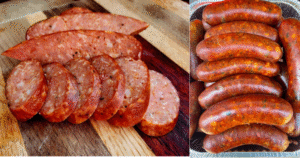Homemade sausage brings the authentic flavors of traditional charcuterie to your kitchen with complete control over ingredients and quality. This classic pork sausage recipe combines ground meat with aromatic spices and herbs to create fresh links that far surpass store-bought alternatives. While the process requires patience and proper technique, the hands-on approach allows you to customize flavors and avoid unwanted preservatives for truly exceptional results.
Recipe Details
Prep Time: 45 mins
Cook Time: 15 mins (for testing)
Chill Time: 2 hours
Total Time: 3 hours
Servings: 12 sausages (about 2.5 lbs)
Difficulty: Medium
Table of Contents
Ingredients
For the Sausage Meat
- 2 lbs pork shoulder, cut into 1-inch cubes
- 1/2 lb pork back fat or fatback, cut into 1-inch cubes
- 1 1/2 tablespoons kosher salt
- 1 teaspoon freshly ground black pepper
- 1 teaspoon fennel seeds, lightly crushed
- 1 teaspoon dried oregano
- 1/2 teaspoon garlic powder
- 1/2 teaspoon sweet paprika
- 1/4 teaspoon red pepper flakes
- 1/4 teaspoon ground coriander
- 1/4 cup ice-cold white wine
- 2 tablespoons ice water
For Casing and Assembly
- 6-8 feet natural hog casings, soaked and rinsed
- 2 tablespoons vegetable oil (for cooking test patties)
- Butcher’s twine for linking

Instructions
- Prepare equipment and chill ingredients. Place meat grinder parts (die, auger, blade) and mixing bowl in freezer for 30 minutes. Cut pork shoulder and fat into uniform cubes, then spread on a baking sheet and freeze for 30 minutes until firm but not frozen solid.
- Prepare the casings. Rinse natural hog casings thoroughly under cold running water. Soak in lukewarm water for 30 minutes to soften. Run water through each casing to check for holes and remove excess salt.
- Grind the meat mixture. Using a meat grinder fitted with a medium die (1/4-inch), grind the chilled pork and fat together. Work quickly to keep the mixture cold, and place ground meat directly into a chilled bowl.
- Season and mix. Sprinkle salt, pepper, fennel seeds, oregano, garlic powder, paprika, red pepper flakes, and coriander over the ground meat. Add ice-cold wine and water. Using your hands or a wooden spoon, mix vigorously for 2-3 minutes until the mixture becomes sticky and holds together well.
- Test the seasoning. Form a small patty from the mixture and cook in a skillet over medium heat for 2-3 minutes per side until cooked through. Taste and adjust seasonings as needed before stuffing casings.
- Stuff the casings. Thread one end of a casing onto the sausage stuffer horn, leaving 3 inches hanging loose. Fill the stuffer with meat mixture and begin feeding steadily, supporting the emerging sausage with your free hand. Fill casings firmly but not too tightly, leaving room for linking.
- Form individual links. Starting 4 inches from one end, pinch and twist the sausage at 5-6 inch intervals to create individual links. Twist alternating links in opposite directions to prevent unwinding. Tie off both ends with butcher’s twine.
- Rest and firm up. Hang linked sausages or arrange on a wire rack set over a baking sheet. Refrigerate uncovered for 2 hours to allow casings to firm and flavors to meld.
- Prick and prepare for cooking. Using a sterilized needle or sausage pricker, make small holes every inch along each sausage to prevent bursting during cooking. This step is crucial for even cooking.
- Cook when ready. Fresh homemade sausages can be grilled, pan-fried, or poached. Cook over medium heat for 12-15 minutes, turning frequently, until internal temperature reaches 160°F (71°C) and juices run clear.
Tips for Success
Maintain proper temperature throughout. Keep meat mixture below 35°F during grinding and mixing. Warm meat creates a mushy texture and can lead to food safety issues. Work in small batches if necessary.
Achieve the right fat ratio. The 80/20 lean-to-fat ratio is crucial for juicy, flavorful sausage. Too little fat results in dry links, while too much creates greasy texture. Weigh ingredients for accuracy.
Master the stuffing technique. Fill casings firmly but leave some give – overstuffed sausages will burst during cooking. If casings tear, simply tie off and start a new section.
Test before committing. Always cook a small test patty to check seasoning balance. It’s much easier to adjust spices before stuffing than after the sausages are completed.
Recipe Variations
Italian-Style Sausage: Increase fennel seeds to 2 teaspoons and add 1 tablespoon minced fresh garlic. For hot Italian, double the red pepper flakes and add 1/2 teaspoon cayenne.
Breakfast Sausage: Replace fennel and oregano with 1 teaspoon sage, 1/2 teaspoon thyme, and 1/4 teaspoon nutmeg. Add 1 tablespoon brown sugar for traditional breakfast flavor.
Chorizo-Style: Add 2 tablespoons smoked paprika, 1 tablespoon sweet paprika, 1 teaspoon cumin, and substitute red wine for white wine.
Apple Chicken Sausage: Use ground chicken thighs and add 1/2 cup finely diced Granny Smith apple, 1 teaspoon sage, and 1/2 teaspoon cinnamon.
Storage Instructions
Fresh homemade sausages keep in the refrigerator for 3-4 days or can be frozen for up to 3 months. Wrap individually in plastic wrap before freezing to prevent sticking together.
For longer storage, consider smoking or curing the sausages using traditional preservation methods. Properly cured sausages can last several weeks refrigerated.
Cooked sausages can be refrigerated for up to 1 week and reheated gently in a skillet or oven until warmed through.
Nutritional Highlights
Each homemade sausage contains approximately 220 calories with 18 grams of protein. By making sausage at home, you control sodium levels and eliminate unnecessary preservatives while ensuring quality meat sources.
The natural casings provide additional protein and minerals, while the lean pork contributes B vitamins, iron, and zinc essential for energy metabolism.
Equipment and Safety Notes
Essential equipment includes a meat grinder, sausage stuffer, and accurate scale. Many stand mixers offer grinder and stuffer attachments that work well for home production.
Always maintain proper food safety by keeping ingredients cold, sanitizing equipment, and cooking sausages to proper internal temperature. Never leave raw sausage mixture at room temperature for extended periods.
Serving and Cooking Ideas
Homemade sausages shine when grilled over medium coals, developing a crispy exterior while maintaining juicy interiors. Serve with sautéed peppers and onions for classic Italian-style presentation.
For breakfast applications, slice and brown in a skillet, then use the rendered fat to cook eggs or hash browns. The superior flavor of homemade sausage elevates simple breakfast dishes significantly.
These artisanal links also excel in pasta dishes, pizza toppings, or hearty stews where their complex seasoning adds depth to the overall flavor profile.
Whether you’re seeking to avoid commercial preservatives, customize flavors to your taste, or simply enjoy the satisfaction of traditional food crafts, homemade sausage represents a rewarding culinary skill that connects you with generations of food artisans.


